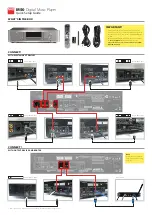
44
Oversampling 3 (Bezier-interpolator plus IIR-filter)
In this process an ideal Bezier interpolator is combined with what is known as
an IIR filter. This eliminates the problematic pre-echo of the FIR method. This
process produces highly „analogueue“ system characteristics, with a sound
quality and measured performance similar to those of good analogueue record
players.
Frequency response and transient characteristics of the Bezier
interpolator plus IIR filter
Oversampling 4
(pure
Bezier
interpolator)
This process delivers a perfect reconstruction of the original music signal. It
exhibits no pre- or post-echoes of any kind, and does not add coloration or
timing errors to the original signal. In sonic terms this method offers an
impressive blend of naturalness, good dynamics and accuracy.
Frequency response and transient characteristics of the Bezier
interpolator
Frequency bandwidth of the analogueue reconstruction filter
Normal operation up to 60 kHz and 'Wide'-Mode up to 120 kHz
The
'
WIDE
'
setting produces the best sound quality, but only with high-quality
amplifiers which are able to process signal frequencies up to 300 kHz without
generating distortion.
If you are in any doubt about the ability of your amplifier to deal with very high
signal frequencies up to 300 kHz, please check this with the manufacturer of
your equipment.
Alternatively you can set the switch to the WIDE setting, and simply listen to the
results. If you hear no interference, and if the sound image is better than that in
the NORMAL setting, leave in the WIDE mode.
Frequency bandwidth of the two settings
The 'WIDE' setting can be used without restriction with all
amplifiers













































